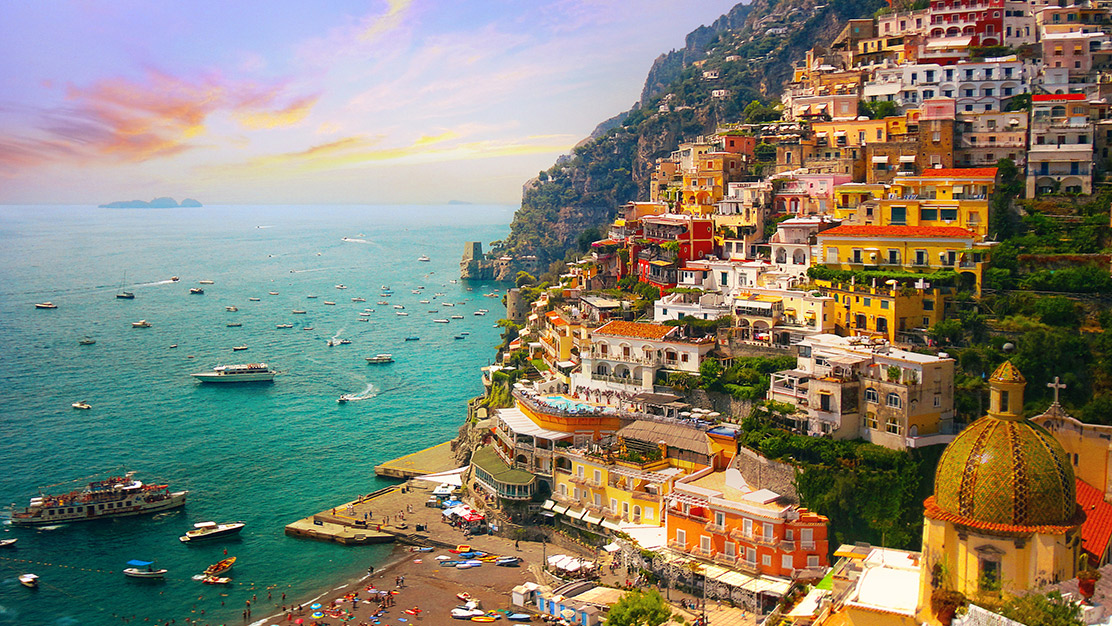Pearl of the Amalfi Coast, Positano looks like a group of pastel-colored houses clinging to the steep wall of the last offshoots of the Lattari Mountains, which are reflected in a clear sea, surrounded by the intense scent of lemon groves and the bright and bright colors of the bougainvillea.
Following, a maze of alleys and steps between shops displaying the typical products of local craftsmanship, which, together with the undisputed landscape beauties, has contributed to making Positano and the Amalfi Coast famous all over the world.
We refer to the fresh linen dresses in the "Positano fashion" style, to the leather or leather sandals, to the multicolored ceramics and to limoncello.
The panorama extends to Punta Licosa and Capri and, just three miles away from the coast, the three islets of "Li Galli" (the Gallo Lungo, the Rotonda and the Castelluccio) emerge from the sea, once home to the enchanting sirens, and recently by dancers of the caliber of Nurejev and Massine.
There is no certain information about the first inhabitants of the area: there are those who hypothesize a primitive Osco or Piceno settlement. However, as often happens, where history cannot reach the legend which, in this case, tells of a deep love between the god of the sea Neptune and the nymph Pasitea.
The Roman nobility subsequently built their luxurious seaside villas here: one on the Gallo Lungo island (the remains of which, however, are no longer visible as they are located under the modern villa of the choreographer Leonide Massine, who in the 1920s bought Li Galli) and another recently rediscovered during the restoration of the crypt and bell tower of the Church of Santa Maria Assunta.
It followed the fate of the ancient maritime republic of Amalfi and suffered, like the other coastal towns, the continuous raids of pirates.
Already after the First World War it was elected by numerous Russian and German artists and writers as their home, being able to benefit from an atmosphere of calm and serenity here. But it was after World War II that Positano became a popular destination for the international jet-set: painters, writers, artists, actors and directors from all over the world came here to savor the authentic pleasure of a simple and genuine life.
Among the most interesting sites, we mention:
- the Church of Santa Maria Assunta, whose original layout dates back to the 10th century and underwent considerable alterations in the 18th century. Outside it is flanked by a beautiful bell tower decorated at the base with bas-relief motifs. The yellow and green majolica dome is splendid and majestic. Remains of the Byzantine floor are still visible in the apse; of the same period is also the prodigious wooden icon depicting the Black Madonna that tradition has it that arrived here by sea. A very valuable example of Neapolitan goldsmith art is the reliquary of San Vito, dating back to the early years of the sixteenth century.
- the Chiesa Nuova (or Church of the Madonna delle Grazie), dating back to the 18th century and built on a pre-existing chapel dedicated to the Blessed Sacrament. In Baroque style and with an elliptical plan, the interior, large and bright, is full of art treasures.
- the Chapel of San Giovanni, consisting of a rectangular room covered with a barrel vault and a floor decorated with the wind rose;
- the Church of San Matteo, decorated with stuccoes, pilasters in relief and a stoup in red porphyry;
- the Church of San Giacomo, in the Liparlati district, dating back to the 12th century;
- the Chapel of Santa Caterina, built by the sailors who traded with Alexandria in Egypt, where the Saint is greatly venerated;
- the small Church of Santa Margherita, located along the road that leads to Fornillo beach, with a terracotta floor partially majolica with floral motifs;
- the Church of the Holy Rosary, of ancient origins, which houses a Roman sarcophagus;
- the Chapel of San Pietro, in the hamlet of Laurito;
- the Church of Santa Maria delle Grazie, in the hamlet of Montepertuso;
- the Church of the Holy Cross, in the hamlet of Nocelle;
- the antisaracene watchtowers, which are part of the complex defense system of the Amalfi Coast (Torre di Fornillo, Torre Trasita, Torre Sponda and Torre Gallo);
- Grotta La Porta, where traces of human settlements dating back to the Paleolithic were found.
Positano is reached by the motor ships and the trips of the Capitan Morgan with stops between 2 (if combined with another location) and 5 hours.
